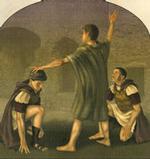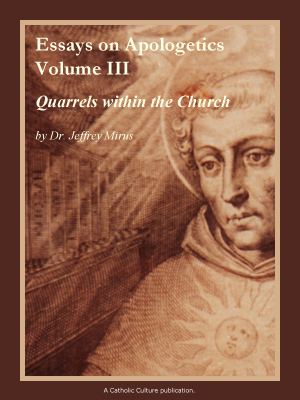The Murder of a Priest
By Dr. Jeff Mirus ( bio - articles - email ) | Jan 15, 2010
When she was twelve years old, Ruth Stephenson was found sitting on the porch of the rectory of St. Paul’s Church in Birmingham, Alabama. She lived about a block away and was very attracted by the quiet faith of Catholics as they entered and left their church each day of the week. By chance, Ruth’s father happened by, saw her talking with the pastor, Fr. James Coyle, and peremptorily ordered her home. Six years later, on August 11, 1921, Ruth’s father murdered Fr. Coyle in broad daylight on that same porch by putting a bullet through his head.
Edwin Stephenson claimed to be a Methodist minister, but he had no church, and he made a living by hanging around the courthouse in the same block, offering to marry, for a modest fee, runaway kids and others who wanted to tie the knot quickly, without their parents’ knowledge. Apparently trade was brisk; he averaged more than three weddings a day. Previously, he had served as a barber, having been dismissed from the barber’s trade association for embezzling funds. In any case, he much preferred the dignity of the cloth. Ruth was the only child of Edwin Stephenson and his wife, Mary.
A World of Prejudice
Stephenson shared the common religious and racial prejudices of the American Southeast in the early 20th century, a time and place in which the once-discredited Ku Klux Klan was making a huge comeback. It was not uncommon for the Klan, and other organizations such as True Americans, to play key roles in the careers of public servants, from police personnel to politicians. Most remarkably in this instance, a young attorney named Hugo Black joined the Klan and rode its power to the U.S. Senate just after he completed his defense in the murder trial of Edwin Stephenson. Over three decades later Black became an associate justice of the Supreme Court, but by then the winds of change were blowing strong, and he often voted to extend civil rights. Earlier in the century, the Klan was known to secretly and not-so-secretly intimidate, injure and even kill members of ethnic and religious minorities and those who sympathized with them—such as witnesses and jurors in murder cases.
Ruth was little influenced by her parents’ prejudices. There is some corroborating evidence that they consistently abused her, as Ruth claimed, once she betrayed an interest in Catholicism, confining her and beating her with a strap, sometimes with police guards outside who denied that anything was amiss within. They even had papers drawn up to commit their daughter to an asylum. By Ruth’s own account, her parents’ attitudes and treatment slowly dissolved any love she felt for them and turned her increasingly toward the Catholic Church. Nothing changed when she reached her majority, so Ruth took matters into her own hands. She secretly received instruction from the sisters at the Convent of Mercy, and she was baptized at Our Lady of Sorrows on April 10, 1921. Her parents discovered her conversion shortly before her First Communion. They beat her, at age 18, more severely than ever.
Unfortunately, it is all too easy to understand Edwin Stephenson’s horror at his daughter’s behavior. To him, it was enough to explain his hatred of Catholics that he had raised his daughter to be a “Christian”. He regularly read and discussed the contents of the anti-Catholic rags of his day, whose combined paid circulation ran into the millions. Indeed, one of their publishers paid for his defense. He was horrified by the frequent accounts of arms stockpiled by the Knights of Columbus against the day when the Pope would give the signal for a Catholic takeover of the United States. He dwelt on descriptions of the lurid tactics through which Catholics seduced, kidnapped, deflowered and imprisoned young girls in convents everywhere. Even the Maria Monk stories, which had been thoroughly discredited in the 19th century, were given new legs as white southern Protestant leaders capitalized on the anxieties occasioned by both World War I and large new waves of immigration.
Catholics in Alabama
If Ruth’s father was an avid reader of such propaganda, Fr. James Coyle was the focal point of the Catholic defense in Birmingham, living too close for comfort right down the street. Coyle came from a race of fighters against Protestant injustice in Ireland, and he did not shy from advising his parishioners to stand up for themselves or from writing extremely cogent letters to the editor protesting the misrepresentations of Catholicism so frequently reported in the general press. We may not be surprised that his bishop attempted to tone Fr. Coyle down a bit—and he complied, admitting himself that his spirited defense sometimes made things worse—but the bishop also had considerable confidence in Fr. Coyle and the priest continued to find ways to refute the charges of his Church’s enemies. Each evening, Fr. Coyle would take his unfinished paperwork and his Breviary out on his porch, chat with passersby, pray his Office, and make notes for his sermons and letters.
Under Alabama law, a young woman wasn’t free of parental control even at age eighteen unless she married, which she could then do without parental consent. Years earlier, Ruth Stephenson had been attracted to Pedro Gussman, a Puerto Rican wallpaper hanger of Spanish descent—a steady, reliable, fit and good-looking man who boarded with the Stephensons for some weeks while remodeling their home. Gussman was twenty-four years older than Ruth, though the age difference was by no means unheard of at that time. He first thought of marrying her when she was just 13. Although the two saw each other relatively rarely over the next five years, his interest remained. For whatever combination of reasons, when Ruth turned eighteen, she accepted Pedro’s proposal. This would end Protestant coercion in her life, for Pedro Gussman was a Catholic.
For obvious reasons, the couple laid a plan which was both secret and swift: A lunch-hour bus ride to a neighboring jurisdiction where they could get the license, and a short walk to a nearby Catholic church to have the priest marry them, as provided by law. The plan almost foundered when the priest in question proved to be away from his rectory, but Ruth and Pedro took the risk of going back to St. Paul’s and Fr. Coyle—the risk that they would be discovered by Ruth’s father, who haunted the courthouse in the same block. For his part, Fr. Coyle agreed to celebrate the marriage without banns, as he was permitted to do under the circumstances, but he did so with at least some personal trepidation. Perhaps partly because his life had been threatened several times over the past few years already, he told his younger assistant: “Her father will probably kill me for this.”
In point of fact, he did. Having heard of the marriage later the same day (at Fr. Coyle’s insistence, Ruth had left a message for him), Edwin Stephenson took his gun, walked the short distance to the rectory where he knew Fr. Coyle would be on the porch, opened the gate, approached the porch, drew his weapon, and fired three shots into the priest’s body. The shot that killed him passed straight through his head.
Birmingham on Trial
The trial that followed was one of the most famous, and the most watched, in American history. Stephenson was prosecuted by Joseph Tate, who was voted out of office forever after; the defense was led by Hugo Black, the only member of the defense team not already enrolled in the Klan, with results for Black’s career that we have already noticed. Astoundingly, Stephenson pleaded not guilty for reasons of both self-defense and temporary insanity. Several witnesses gave significant evidence refuting both claims, including one who had seen the entire episode from start to finish. Nonetheless, the jury seemed swayed by Black’s emphasis on the horrors Stephenson and his poor wife had endured in raising their daughter amidst the efforts of Catholics to invade their sacred home and destroy their only child’s life. And if there were any cause to doubt the depravity to which the rebellious and ungrateful Ruth Stephenson had sunk, Black suggested, one need not look further for confirmation than Pedro Gussman’s dark complexion.
Gussman was not a “negro”, as more than a decade of employment and social interaction in Birmingham, including his right to vote, made exceedingly clear to everybody outside of the context of this case. But if—just perhaps—he was really secretly of African descent, then Ruth and Fr. Coyle had conspired not only to violate Alabama law but to perpetrate something which to Klansmen was akin to bestiality, a moral degradation sufficient to strike fear and outrage into every true “Christian” and “American” on the jury. Hugo Black dimmed the light in the courtroom before forcing Pedro Gussman to stand bewildered facing the jury so that they could see for themselves the swarthiness of his skin. Then he badgered Gussman in the witness stand about what he had done to straighten his dark curly hair! (In actuality, Edwin Stephenson himself had sometimes tended to Gussman’s hair when he was a barber; white barbers did not permit black clients in their shops.)
How did the trial end? How did the lives of Ruth and Pedro turn out? I leave you to discover these things by reading the brilliant and moving new book by Sharon Davies, a specialist in criminal law at Ohio State University’s Moritz College of Law. I’ve just finished it, and I couldn’t put it down. The title, Rising Road, is drawn from a famous Irish blessing. The author is deeply sympathetic to the Catholic position; the book frequently had me in tears. This is both a riveting human drama and an important exposé of religious prejudice. Every American should read it in order to more fully understand what it meant to be Catholic in America less than a century ago. But when contemporary Catholics read it, they will hear echoes of a grim past in the newly-secularized anti-Catholicism of our own time.
[Sharon Davies, Rising Road: A True Tale of Love, Race, and Religion in America (Oxford University Press, New York: 2010) Includes photos. Hardback, 327 pp.]
All comments are moderated. To lighten our editing burden, only current donors are allowed to Sound Off. If you are a current donor, log in to see the comment form; otherwise please support our work, and Sound Off!








